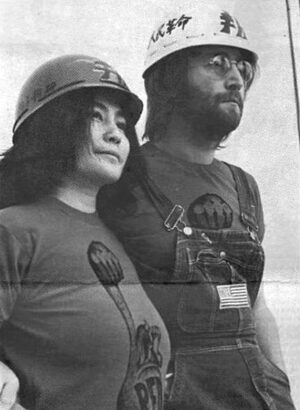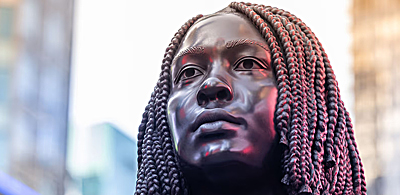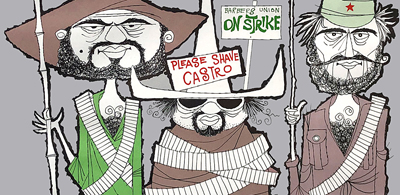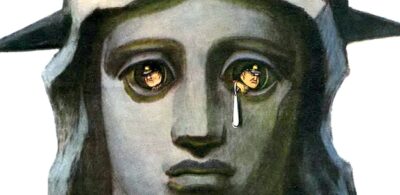John Lennon and I
The political activist side of John Lennon seems to have been largely dismissed or forgotten by the general public, and corporate media reports on the anniversary of his murder are not likely to mention anything more controversial than Beatlemania.
Obviously Lennon had an enormous impact upon my generation, setting us free with the primal rhythms and energy of rebellious rock ‘n roll – but to me he was always more than just a member of the Beatles. Millions of words have been written about John Lennon, and the world doesn’t really need to read what I have to say about the ex-Beatle; but since he influenced me as an artist and you are reading my web log – you might be interested in my take on his life and times.
While it’s true that many Beatles fans in the West resented and disliked Yoko Ono, blaming her for the breakup of the Fab Four, I was always intrigued by her; perhaps because I live in a city with a large Japanese population and I was already studying Japanese culture and aesthetics. While I didn’t care for Ono’s art or her singing, I always thought of John and Yoko as a couple.

I recall being a teenager in 1971 and seeing a black and white photograph in the underground press of John and Yoko wearing the crash helmets of the Zengakuren (All-Japan Federation of Student Autonomies), the violent neo-Marxist Japanese students who rose in rebellion in 1968.
The antiwar movement in Japan opposed US bases in Japan being used to prosecute the Vietnam war, and the Zengakuren took advantage of that resentment.
Originally a small grouping, their influence became widespread as they hijacked antiwar protests to the point that any massive antiwar demonstration in Japan came to be referred to as “Zengakuren.”

Demonstrations by Zengakuren were highly disciplined affairs where thousands of participants dressed in crash helmets and carried long wood poles they called “violence sticks.” Chanting revolutionary slogans they marched in the streets in military fashion, and fought with police using their wooden staves. Those militant protest marches had the look and feel of ancient Japanese peasant uprisings, and it was John and Yoko who naively brought that slice of dissident Japanese life to the attention of the West.
The International Marxist Group of Great Britain conducted an interview with John and Yoko that appeared in the March 22, 1971 edition of the Trotskyist group’s underground paper, The Red Mole. The paper published several photographs of John and Yoko posing in their Zengakuren gear. Interestingly enough the militant Japanese group wasn’t even mentioned in the interview, but the photos travelled around the world.
John and Yoko’s Zengakuren photographs have almost been completely eradicated from public memory; if you do come across them you’ll get no background information on the Zengakuren connection. For instance, on the Wikipedia page describing the Power to the People song, Lennon is described as simply wearing “a white hard helmet.”
Songs like the 1971 Power To The People not only captured the spirit of the day, they landed Lennon on President Nixon’s “enemies list.” The director of the FBI at the time, J. Edgar Hoover, considered Lennon to be a dangerous extremist, and the Nixon administration did everything within its power to have the rocker deported.
The FBI kept Lennon under surveillance in the US for a number of years, tapping his phone, watching his apartment, and following him wherever he went. His FBI file was nearly three hundred pages long. It is amazing to me that with all of the media attention given to the anniversary of Lennon’s death, the press has failed to mention that the FBI still refuses to release 10 pages of secret files it keeps on the rocker, claiming those files are a matter of “national security.”
Suffice it to say Lennon eventually turned his back on radical left politics, and it’s likely that he considered the Zengakuren and Red Mole entanglements as significant misjudgments. He said as much regarding his Power to the People song, which in retrospect he called “rather embarrassing.” Still, during his days of radicalism, he managed to write political songs that were poignant and on target, his 1971 songs Gimme Some Truth and How Do You Sleep come to mind.

While I could write a book on how the life and works of John Lennon influenced me, I’ll offer just one more anecdote. I was working at the offices of the LA WEEKLY newspaper as a production artist and designer when the paper got the news of Lennon’s murder on December 8th, 1980. Most of the staff went into shock, especially those old enough to have been raised on Beatles music.
Panic set in when everyone realized the paper was ready to go to press but the edition didn’t contain a single word on the killing. The presses were literally stopped and the paper’s editor became alarmed when he understood that, even if he managed to write an editorial on the tragedy there would still not be enough time to produce an appropriate artwork for the paper’s cover. That’s when I stepped in; with an hour to spare I designed a quick graphic tribute to the rocker, that illustration is shown at right.
The day before Lennon’s slaying there was another death in the rock ‘n roll family, Darby Crash committed suicide. Crash was the outrageous front man for the Germs, one of LA’s first and most notorious punk bands, and his death also hit me like a ton of bricks. I had been deeply involved in LA’s punk scene since it raised its ugly head in 1977, and Crash’s demise was evidence that punk was indeed imploding. It was certainly true that Lennon’s death represented the “death of an era,” but Crash’s death represented a stillborn era.
Suffice it to say, that week in December was pretty rough, but I managed to create a cover for the WEEKLY despite having no time and even fewer resources. The cover was a simple photo manipulation of Lennon, a somber “basic black” graphic reliant upon an extra-large dot pattern. It was a personal farewell to a man who had helped shape the world view of my generation.
UPDATED 10/9/2016: The complete secret FBI files on John Lennon were finally released on December 20, 2006.




